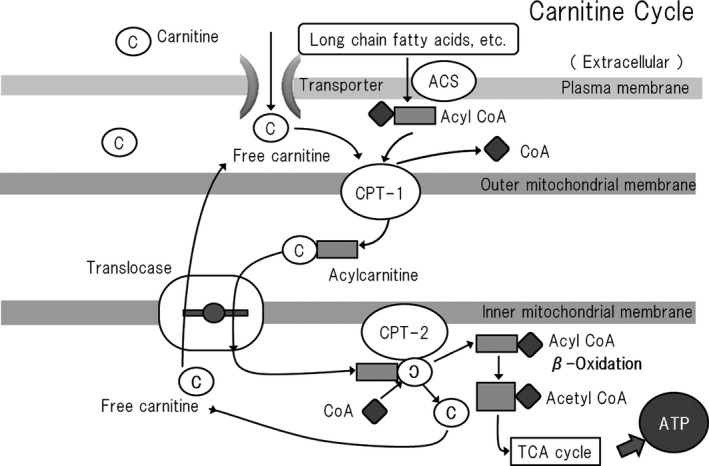FIGURE 1.

The carnitine shuttle system. Carnitine is necessary for the transport of fatty acids into mitochondria, which is accomplished as part of the long‐chain fatty acid transport system, referred to as the carnitine circuit or carnitine shuttle, which also comprises several enzymes in the mitochondrial membrane, and plays an important role in energy production from fatty acids. Organic ion/carnitine transporter 2 (OCTN2) is expressed in cell membranes and has the effect of concentrating carnitine to 20–50 times its extracellular concentration. Free fatty acids are converted to acyl‐CoAs by long‐chain acyl‐CoA synthetase (ACS) on the outer mitochondrial membrane and then transported into the space between the outer and inner mitochondrial membranes. Here, a reaction between acyl‐CoA and carnitine occurs that is catalyzed by carnitine palmitoyltransferase I (CPT‐1) on the inside of the outer mitochondrial membrane, and the acylcarnitine generated is transported to the inner mitochondrial matrix by carnitine acylcarnitine translocase (CACT) on the inner mitochondrial membrane. The acylcarnitine is then broken down to liberate carnitine and long‐chain fatty acids by carnitine palmitoyltransferase 2 (CPT‐2) that is expressed inside the inner mitochondrial membrane, and the released fatty acids undergo β‐oxidation in the mitochondrial matrix to generate energy. Free carnitine then returns to the intermembrane space via CACT. Thus, free carnitine and acylcarnitine are transported in opposite directions, whether the movement of acylcarnitine is inward or outward. However, this circuit cannot operate if there is an absolute deficiency of free carnitine or if there is a shortage of free carnitine relative to the amount of acyl‐CoA (carnitine insufficiency) (Angelini et al., 1992). C, carnitine; ACS, acyl‐CoA synthetase; CPT, carnitine palmitoyltransferase, CoA, coenzyme A
